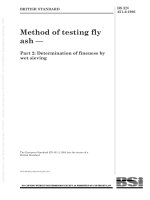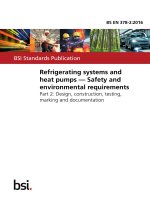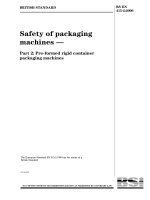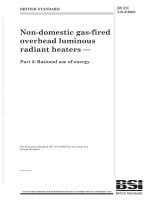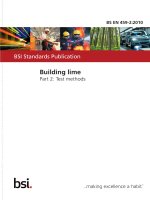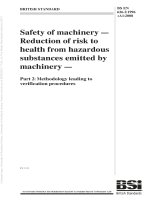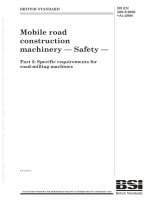Bsi bs en 62453 2 2017
Bạn đang xem bản rút gọn của tài liệu. Xem và tải ngay bản đầy đủ của tài liệu tại đây (7.52 MB, 174 trang )
BS EN 62453-2:2017
BSI Standards Publication
Field Device Tool (FDT)
Interface Specification
Part 2: Concepts and detailed Description
(IEC 62453-2:2016)
BRITISH STANDARD
BS EN 62453-2:2017
National foreword
This British Standard is the UK implementation of EN 62453-2:2017. It
is identical to IEC 62453-2:2016. It supersedes BS EN 62453-2:2009
which is withdrawn.
The UK participation in its preparation was entrusted to Technical Committee AMT/7, Industrial communications: process measurement and
control, including fieldbus.
A list of organizations represented on this committee can be obtained on
request to its secretary.
This publication does not purport to include all the necessary provisions of
a contract. Users are responsible for its correct application.
© The British Standards Institution 2017.
Published by BSI Standards Limited 2017
ISBN 978 0 580 81974 2
ICS 25.040.40; 35.100.05; 35.110
Compliance with a British Standard cannot confer immunity from
legal obligations.
This British Standard was published under the authority of the
Standards Policy and Strategy Committee on 31 March 2017.
Amendments/corrigenda issued since publication
Date
Text affected
BS EN 62453-2:2017
EUROPEAN STANDARD
EN 62453-2
NORME EUROPÉENNE
EUROPÄISCHE NORM
March 2017
ICS 25.040.40; 35.100.05; 35.110
Supersedes EN 62453-2:2009
English Version
Field Device Tool (FDT) Interface Specification - Part 2:
Concepts and detailed Description
(IEC 62453-2:2016)
Spécification des interfaces des outils des dispositifs de
terrain (FDT) - Partie 2: Concepts et description détaillée
(IEC 62453-2:2016)
Field Device Tool (FDT)-Schnittstellenspezifikation - Teil 2:
Konzept und grundlegende Beschreibung
(IEC 62453-2:2016)
This European Standard was approved by CENELEC on 2017-01-20. CENELEC members are bound to comply with the CEN/CENELEC
Internal Regulations which stipulate the conditions for giving this European Standard the status of a national standard without any alteration.
Up-to-date lists and bibliographical references concerning such national standards may be obtained on application to the CEN-CENELEC
Management Centre or to any CENELEC member.
This European Standard exists in three official versions (English, French, German). A version in any other language made by translation
under the responsibility of a CENELEC member into its own language and notified to the CEN-CENELEC Management Centre has the
same status as the official versions.
CENELEC members are the national electrotechnical committees of Austria, Belgium, Bulgaria, Croatia, Cyprus, the Czech Republic,
Denmark, Estonia, Finland, Former Yugoslav Republic of Macedonia, France, Germany, Greece, Hungary, Iceland, Ireland, Italy, Latvia,
Lithuania, Luxembourg, Malta, the Netherlands, Norway, Poland, Portugal, Romania, Serbia, Slovakia, Slovenia, Spain, Sweden,
Switzerland, Turkey and the United Kingdom.
European Committee for Electrotechnical Standardization
Comité Européen de Normalisation Electrotechnique
Europäisches Komitee für Elektrotechnische Normung
CEN-CENELEC Management Centre: Avenue Marnix 17, B-1000 Brussels
© 2017 CENELEC All rights of exploitation in any form and by any means reserved worldwide for CENELEC Members.
Ref. No. EN 62453-2:2017 E
BS EN 62453-2:2017
EN 62453-2:2017
European foreword
The text of document 65E/334/CDV, future edition 2 of IEC 62453-2, prepared by SC 65E “Devices
and integration in enterprise systems” of IEC/TC 65 “Industrial process measurement, control and
automation" was submitted to the IEC-CENELEC parallel vote and approved by CENELEC as
EN 62453-2:2017.
The following dates are fixed:
•
latest date by which the document has to be
implemented at national level by
publication of an identical national
standard or by endorsement
(dop)
2017-10-20
•
latest date by which the national
standards conflicting with the
document have to be withdrawn
(dow)
2020-01-20
This document supersedes EN 62453-2:2009.
Attention is drawn to the possibility that some of the elements of this document may be the subject of
patent rights. CENELEC [and/or CEN] shall not be held responsible for identifying any or all such
patent rights.
Endorsement notice
The text of the International Standard IEC 62453-2:2016 was approved by CENELEC as a European
Standard without any modification.
In the official version, for Bibliography, the following notes have to be added for the standards
indicated:
IEC/TR 62453-41
2
NOTE
Harmonized as CLC/TR 62453-41
BS EN 62453-2:2017
EN 62453-2:2017
Annex ZA
(normative)
Normative references to international publications
with their corresponding European publications
The following documents, in whole or in part, are normatively referenced in this document and are
indispensable for its application. For dated references, only the edition cited applies. For undated
references, the latest edition of the referenced document (including any amendments) applies.
NOTE 1 When an International Publication has been modified by common modifications, indicated by (mod), the relevant
EN/HD applies.
NOTE 2 Up-to-date information on the latest versions of the European Standards listed in this annex is available here:
www.cenelec.eu.
Publication
IEC 61131
IEC 62453-1
Year
series
2016
IEC 62453-3xy
series
IEC/TR 62390
2005
Title
Programmable controllers
Field Device Tool (FDT) interface
specification -- Part 1: Overwiew and
guidance
Field device tool (FDT) interface
specification
Common automation device - Profile
guideline
EN/HD
EN 61131
FprEN 62453-1
Year
series
2013
EN 62453-3xy
series
-
-
3
–2–
BS EN 62453-2:2017
IEC 62453-2:2016 © IEC 2016
CONTENTS
FOREWORD ......................................................................................................................... 10
INTRODUCTION ................................................................................................................... 12
1
Scope ............................................................................................................................ 13
2
Normative references .................................................................................................... 13
3
Terms, definitions, symbols, abbreviated terms and conventions ................................... 13
3.1
Terms and definitions ............................................................................................ 13
3.2
Symbols and abbreviated terms ............................................................................ 14
3.3
Conventions .......................................................................................................... 14
3.3.1
Use of UML ................................................................................................... 14
3.3.2
State availability statement ............................................................................ 14
3.3.3
Data type names and references to data types .............................................. 14
4
Fundamentals ................................................................................................................ 14
4.1
General ................................................................................................................. 14
4.2
Abstract FDT model .............................................................................................. 14
4.2.1
FDT model overview ...................................................................................... 14
4.2.2
Frame Application (FA) .................................................................................. 18
4.2.3
Device Type Manager (DTM) ......................................................................... 19
4.2.4
Channel object .............................................................................................. 26
4.3
Modularity ............................................................................................................. 28
4.4
Bus categories ...................................................................................................... 29
4.5
Identification ......................................................................................................... 29
4.5.1
DTM instance identification ............................................................................ 29
4.6
System and FDT topology ..................................................................................... 30
4.7
FDT Communication ............................................................................................. 32
4.7.1
General ......................................................................................................... 32
4.7.2
Handling of communication requests ............................................................. 33
4.7.3
Handling of communication errors .................................................................. 33
4.7.4
Handling of loss of connection ....................................................................... 33
4.7.5
Point–to-point communication ........................................................................ 33
4.7.6
Nested communication .................................................................................. 34
4.8
DTM, DTM Device Type and Hardware Identification Information .......................... 35
4.8.1
DTM and DTM Device Type ........................................................................... 35
4.8.2
Supported hardware identification .................................................................. 36
4.8.3
Connected Hardware Identification ................................................................ 37
4.9
DTM data persistence and synchronization ........................................................... 37
4.10 DTM device parameter access .............................................................................. 38
4.11 DTM state machine ............................................................................................... 39
4.11.1
DTM states .................................................................................................... 39
4.11.2
‘Communication allowed’ sub-states .............................................................. 40
4.12 Basic operation phases ......................................................................................... 41
4.12.1
Roles and access rights ................................................................................. 41
4.12.2
Operation phases .......................................................................................... 41
4.13 FDT version interoperability .................................................................................. 42
4.13.1
Version interoperability overview ................................................................... 42
4.13.2
DTM and device versions............................................................................... 43
4.13.3
Persistence ................................................................................................... 43
4.13.4
Nested communication .................................................................................. 43
BS EN 62453-2:2017
IEC 62453-2:2016 © IEC 2016
5
–3–
FDT session model and use cases ................................................................................ 44
5.1
Session model overview........................................................................................ 44
5.2
Actors ................................................................................................................... 45
5.3
Use cases ............................................................................................................. 47
5.3.1
Use case overview ......................................................................................... 47
5.3.2
Observation ................................................................................................... 47
5.3.3
Operation ...................................................................................................... 47
5.3.4
Maintenance .................................................................................................. 50
5.3.5
Planning ........................................................................................................ 55
5.3.6
OEM service .................................................................................................. 58
5.3.7
Administration................................................................................................ 58
6
General concepts .......................................................................................................... 59
6.1
Address management ........................................................................................... 59
6.2
Scanning and DTM assignment ............................................................................. 60
6.2.1
Scanning overview ......................................................................................... 60
6.2.2
Scanning ....................................................................................................... 60
6.2.3
DTM assignment ............................................................................................ 61
6.2.4
Manufacturer specific device identification ..................................................... 61
6.2.5
Scan for communication hardware ................................................................. 62
6.3
Configuration of Fieldbus Master or Communication Scheduler ............................. 62
6.4
PLC tool support ................................................................................................... 63
6.4.1
General ......................................................................................................... 63
6.4.2
Process image modifications while PLC is running ......................................... 64
6.5
Slave redundancy ................................................................................................. 65
6.5.1
Redundancy overview .................................................................................... 65
6.5.2
Redundancy support in Frame Application ..................................................... 66
6.5.3
Parent component for redundant fieldbus ....................................................... 66
6.5.4
Redundancy support in Device DTM .............................................................. 66
6.5.5
Scan and redundant slaves ............................................................................ 67
7
FDT service specification ............................................................................................... 67
7.1
Service specification overview .............................................................................. 67
7.2
DTM services ........................................................................................................ 68
7.2.1
General services............................................................................................ 68
7.2.2
DTM services related to installation ............................................................... 70
7.2.3
DTM services related to DTM/device information ........................................... 70
7.2.4
DTM services related to the DTM state machine ............................................ 73
7.2.5
DTM services related to functions .................................................................. 75
7.2.6
DTM services related to channel objects – service GetChannels ................... 78
7.2.7
DTM services related to documentation – service GetDocumentation ............ 79
7.2.8
DTM services to access the instance data ..................................................... 79
7.2.9
DTM services to evaluate the instance data ................................................... 80
7.2.10
DTM services to access the device data ........................................................ 81
7.2.11
DTM services related to network management information ............................ 83
7.2.12
DTM services related to online operation ....................................................... 84
7.2.13
DTM services related to data synchronization ................................................ 85
7.2.14
DTM services related to import and export ..................................................... 87
7.3
Presentation object services ................................................................................. 88
7.4
Channel object service .......................................................................................... 88
7.4.1
Channel object service overview .................................................................... 88
–4–
BS EN 62453-2:2017
IEC 62453-2:2016 © IEC 2016
7.4.2
Service ReadChannelInformation ................................................................... 88
7.4.3
Service WriteChannelInformation ................................................................... 88
7.5
Process Channel object services – services for I/O related information ................. 89
7.5.1
Service ReadChannelData ............................................................................. 89
7.5.2
Service WriteChannelData ............................................................................. 89
7.6
Communication Channel object services ............................................................... 90
7.6.1
Services related to communication ................................................................ 90
7.6.2
Services related to sub-topology management ............................................... 93
7.6.3
Services related to GUI and functions ............................................................ 96
7.6.4
Service Scan ................................................................................................. 96
7.7
Frame Application services ................................................................................... 97
7.7.1
General state availability ............................................................................... 97
7.7.2
FA services related to general events ............................................................ 97
7.7.3
FA services related to topology management ................................................. 98
7.7.4
FA services related to redundancy ............................................................... 101
7.7.5
FA services related to storage of DTM data ................................................. 102
7.7.6
FA services related to DTM data synchronization......................................... 103
7.7.7
FA service related to process image validation – service
ValidateProcessImage ................................................................................. 104
7.7.8
FA services related to presentation .............................................................. 105
7.7.9
FA Services related to audit trail – service RecordAuditTrailEvent ............... 106
8
FDT dynamic behavior ................................................................................................. 107
8.1
8.1.1
8.1.2
8.2
8.2.1
8.2.2
8.2.3
8.2.4
8.3
8.3.1
8.3.2
8.3.3
8.3.4
8.4
8.5
8.5.1
8.5.2
8.5.3
8.6
8.7
8.7.1
8.7.2
8.7.3
8.7.4
8.7.5
8.8
8.9
Generate FDT topology ....................................................................................... 107
FDT topology generation triggered by the Frame Application ....................... 107
FDT topology generation triggered by the DTM ............................................ 107
Address setting ................................................................................................... 108
Address setting overview ............................................................................. 108
Set or modify device address – with user interface ...................................... 108
Set or modify device address – without user interface ................................. 109
Display or modify all child device addresses with user interface .................. 109
Communication ................................................................................................... 110
Communication overview ............................................................................. 110
Point-to-point communication ....................................................................... 110
Nested communication ................................................................................ 111
Device initiated data transfer ....................................................................... 112
Scanning and DTM assignment ........................................................................... 113
Multi-user scenarios ............................................................................................ 114
General ....................................................................................................... 114
Synchronized and non-synchronized locking mechanism for DTMs .............. 116
Additional rules ............................................................................................ 118
Notification of changes........................................................................................ 118
DTM instance data state machines ..................................................................... 118
Instance data set overview .......................................................................... 118
Modifications state machine ......................................................................... 119
Persistence state machine ........................................................................... 120
Modification in device .................................................................................. 120
Storage life cycle ......................................................................................... 121
Parent component handling redundant slave ....................................................... 122
DTM upgrade ...................................................................................................... 124
BS EN 62453-2:2017
IEC 62453-2:2016 © IEC 2016
–5–
8.9.1
General rules ............................................................................................... 124
8.9.2
Saving data from a DTM to be upgraded ...................................................... 124
8.9.3
Loading data in the replacement DTM.......................................................... 125
Annex A (normative) FDT data types definition .................................................................. 126
A.1
General ............................................................................................................... 126
A.2
Basic data types ................................................................................................. 126
A.3
General data types.............................................................................................. 127
A.4
User information data types ................................................................................ 144
A.5
DTM information data type .................................................................................. 145
A.6
BTM data types ................................................................................................... 146
A.7
Device and Scan identification data types ........................................................... 147
A.8
Function data types ............................................................................................ 151
A.9
AuditTrail data types ........................................................................................... 154
A.10 Documentation data types ................................................................................... 155
A.11 DeviceList data type ........................................................................................... 156
A.12 Network management data types ........................................................................ 158
A.13 Instance data types ............................................................................................. 159
A.14 DeviceStatus data types ..................................................................................... 164
A.15 OnlineCompare data types .................................................................................. 164
A.16 UserInterface data types ..................................................................................... 165
A.17 Fieldbus-specific data types ................................................................................ 166
Bibliography ........................................................................................................................ 168
Figure 1 – Part 2 of the IEC 62453 series ............................................................................. 12
Figure 2 – Abstract FDT model ............................................................................................. 15
Figure 3 – Frame Application with integrated Communication Channel ................................. 19
Figure 4 – Device Type Manager (DTM) ................................................................................ 19
Figure 5 – Communication DTM ............................................................................................ 20
Figure 6 – Device DTM ......................................................................................................... 21
Figure 7 – Gateway DTM ...................................................................................................... 21
Figure 8 – Composite Device DTM ........................................................................................ 22
Figure 9 – Module DTM ........................................................................................................ 23
Figure 10 – Block Type Manager (BTM) ................................................................................ 24
Figure 11 – Presentation object ............................................................................................ 25
Figure 12 – Channel object ................................................................................................... 26
Figure 13 – Communication Channel .................................................................................... 27
Figure 14 – Combined Process/Communication Channel ...................................................... 28
Figure 15 – Identification of connected devices ..................................................................... 30
Figure 16 – FDT topology for a simple system topology ........................................................ 31
Figure 17 – FDT topology for a complex system topology ..................................................... 32
Figure 18 – Point-to-point communication ............................................................................. 34
Figure 19 – Nested communication ....................................................................................... 35
Figure 20 – DTM, DTM Device Type and Device Identification Information ............................ 36
Figure 21 – Connected Hardware Identification ..................................................................... 37
Figure 22 – FDT storage and synchronization mechanisms ................................................... 38
Figure 23 – DTM state machine ............................................................................................ 39
–6–
BS EN 62453-2:2017
IEC 62453-2:2016 © IEC 2016
Figure 24 – Substates of communication allowed .................................................................. 40
Figure 25 – Main use case diagram ...................................................................................... 45
Figure 26 – Observation use cases ....................................................................................... 47
Figure 27 – Operation use cases .......................................................................................... 48
Figure 28 – Maintenance use cases ...................................................................................... 51
Figure 29 – Planning use cases ............................................................................................ 55
Figure 30 – OEM service ...................................................................................................... 58
Figure 31 – Administrator use cases ..................................................................................... 59
Figure 32 – Address setting via DTM Presentation object ..................................................... 60
Figure 33 – Fieldbus scanning .............................................................................................. 61
Figure 34 – Fieldbus master configuration tool as part of a DTM ........................................... 63
Figure 35 – Process Image ................................................................................................... 64
Figure 36 – Transfer of layout information using ProcessImage services............................... 64
Figure 37 – Redundancy scenarios ....................................................................................... 65
Figure 38 – FDT topology generation triggered by the Frame Applications .......................... 107
Figure 39 – FDT topology generation triggered by a DTM ................................................... 108
Figure 40 – Set or modify device address – with user interface ........................................... 108
Figure 41 – Set or modify device address – without user interface ...................................... 109
Figure 42 – Set or modify all device addresses – with user interface ................................... 110
Figure 43 – Point-to-point communication ........................................................................... 111
Figure 44 – Nested communication ..................................................................................... 112
Figure 45 – Device initiated data transfer ............................................................................ 113
Figure 46 – Scanning and DTM assignment ........................................................................ 114
Figure 47 – Multi-user system ............................................................................................. 115
Figure 48 – General synchronized locking mechanism ........................................................ 116
Figure 49 – General non-synchronized locking mechanism ................................................. 117
Figure 50 – Parameterization in case of synchronized locking mechanism .......................... 117
Figure 51 – Modifications state machine of instance data ................................................... 119
Figure 52 – Persistence state machine of instance data ...................................................... 120
Figure 53 – Management of redundant topology ................................................................. 123
Figure 54 – Associating data to a dataSetId ........................................................................ 124
Figure 55 – Loading data for a supported dataSetId ............................................................ 125
Table 1 – Description of FDT objects .................................................................................... 16
Table 2 – Description of associations between FDT objects .................................................. 17
Table 3 – Transitions of DTM states ...................................................................................... 40
Table 4 – Transitions of DTM ‘communication allowed’ sub states ........................................ 40
Table 5 – Operation phases .................................................................................................. 42
Table 6 – Actors ................................................................................................................... 46
Table 7 – Operation use cases ............................................................................................. 49
Table 8 – Maintenance use cases ......................................................................................... 52
Table 9 – Planning use cases ............................................................................................... 56
Table 10 – Administrator use cases ...................................................................................... 59
BS EN 62453-2:2017
IEC 62453-2:2016 © IEC 2016
–7–
Table 11 – Arguments for service PrivateDialogEnabled ....................................................... 68
Table 12 – Arguments for service SetLanguage .................................................................... 69
Table 13 – Arguments for service SetSystemGuiLabel .......................................................... 70
Table 14 – Arguments for service GetTypeInformation (for DTM) .......................................... 71
Table 15 – Arguments for service GetTypeInformation (for BTM) .......................................... 71
Table 16 – Arguments for service GetIdentificationInformation (for DTM) .............................. 71
Table 17 – Arguments for service GetIdentificationInformation (for BTM) .............................. 72
Table 18 – Arguments for service Hardware information (for DTM) ....................................... 72
Table 19 – Arguments for service GetActiveTypeInfo ............................................................ 72
Table 20 – Arguments for service GetActiveTypeInfo (for BTM) ............................................ 73
Table 21 – Arguments for service Initialize (for DTM) ............................................................ 73
Table 22 – Arguments for service Initialize (for BTM) ............................................................ 73
Table 23 – Arguments for service SetLinkedCommunicationChannel .................................... 74
Table 24 – Arguments for service EnableCommunication ...................................................... 74
Table 25 – Arguments for service ReleaseLinkedCommunicationChannel ............................. 75
Table 26 – Arguments for service ClearInstanceData ............................................................ 75
Table 27 – Arguments for service Terminate ......................................................................... 75
Table 28 – Arguments for service GetFunctions .................................................................... 76
Table 29 – Arguments for service InvokeFunctions ............................................................... 77
Table 30 – Arguments for service GetGuiInformation ............................................................ 77
Table 31 – Arguments for service OpenPresentation ............................................................. 77
Table 32 – Arguments for service ClosePresentation ............................................................ 78
Table 33 – Arguments for service GetChannels .................................................................... 78
Table 34 – Arguments for service GetDocumentation ............................................................ 79
Table 35 – Arguments for service InstanceDataInformation ................................................... 79
Table 36 – Arguments for service InstanceDataRead ............................................................ 80
Table 37 – Arguments for service InstanceDataWrite ............................................................ 80
Table 38 – Arguments for service Verify ................................................................................ 81
Table 39 – Arguments for service CompareDataValueSets ................................................... 81
Table 40 – Arguments for service DeviceDataInformation ..................................................... 81
Table 41 – Arguments for service DeviceDataRead .............................................................. 82
Table 42 – Arguments for service DeviceDataWrite ............................................................... 82
Table 43 – Arguments for service NetworkManagementInfoRead .......................................... 83
Table 44 – Arguments for service NetworkManagementInfoWrite .......................................... 83
Table 45 – Arguments for service DeviceStatus (for DTM) .................................................... 84
Table 46 – Arguments for service CompareInstanceDataWithDeviceData (for DTM) ............. 84
Table 47 – Arguments for service WriteDataToDevice (for DTM) ........................................... 85
Table 48 – Arguments for service ReadDataFromDevice(for DTM) ........................................ 85
Table 49 – Arguments for service OnLockInstanceData ........................................................ 86
Table 50 – Arguments for service OnUnlockInstanceData ..................................................... 86
Table 51 – Arguments for service OnInstanceDataChanged .................................................. 86
Table 52 – Arguments for service OnInstanceChildDataChanged .......................................... 87
Table 53 – Arguments for service Export .............................................................................. 87
–8–
BS EN 62453-2:2017
IEC 62453-2:2016 © IEC 2016
Table 54 – Arguments for service Import ............................................................................... 88
Table 55 – Arguments for service ReadChannelInformation .................................................. 88
Table 56 – Arguments for service WriteChannelInformation .................................................. 89
Table 57 – Arguments for service ReadChannelData ............................................................ 89
Table 58 – Arguments for service WriteChannelData ............................................................ 89
Table 59 – Arguments for service GetSupportedProtocols..................................................... 90
Table 60 – Arguments for service Connect ............................................................................ 90
Table 61 – Arguments for service Disconnect ....................................................................... 91
Table 62 – Arguments for service AbortRequest ................................................................... 91
Table 63 – Arguments for service AbortIndication ................................................................. 92
Table 64 – Arguments for service Transaction ...................................................................... 92
Table 65 – Arguments for service SequenceDefine ............................................................... 93
Table 66 – Arguments for service SequenceStart .................................................................. 93
Table 67 – Arguments for service ValidateAddChild .............................................................. 94
Table 68 – Arguments for service ChildAdded ....................................................................... 94
Table 69 – Arguments for service ValidateRemoveChild ....................................................... 94
Table 70 – Arguments for service ChildRemoved .................................................................. 95
Table 71 – Arguments for service SetChildrenAddresses ...................................................... 95
Table 72 – Arguments for service GetChannelFunctions ....................................................... 96
Table 73 – Arguments for service GetGuiInformation ............................................................ 96
Table 74 – Arguments for service Scan ................................................................................. 97
Table 75 – Arguments for service OnErrorMessage .............................................................. 97
Table 76 – Arguments for service OnProgress ...................................................................... 97
Table 77 – Arguments for service OnOnlineStatusChanged .................................................. 98
Table 78 – Arguments for service OnFunctionsChanged ....................................................... 98
Table 79 – Arguments for service GetDtmInfoList ................................................................. 99
Table 80 – Arguments for service CreateChild (DTM) ........................................................... 99
Table 81 – Arguments for service CreateChild (BTM) ............................................................ 99
Table 82 – Arguments for service DeleteChild..................................................................... 100
Table 83 – Arguments for service MoveChild ...................................................................... 100
Table 84 – Arguments for service GetParentNodes ............................................................. 100
Table 85 – Arguments for service GetChildNodes ............................................................... 101
Table 86 – Arguments for service GetDtm ........................................................................... 101
Table 87 – Arguments for service ReleaseDtm .................................................................... 101
Table 88 – Arguments for service OnAddedRedundantChild ............................................... 102
Table 89 – Arguments for service OnRemovedRedundantChild ........................................... 102
Table 90 – Arguments for service SaveInstanceData .......................................................... 102
Table 91 – Arguments for service LoadInstanceData .......................................................... 103
Table 92 – Arguments for service GetPrivateDtmStorageInformation .................................. 103
Table 93 – Arguments for service LockInstanceData ........................................................... 103
Table 94 – Arguments for service UnlockInstanceData........................................................ 104
Table 95 – Arguments for service OnInstanceDataChanged ................................................ 104
Table 96 – Arguments for service ValidateProcessImage .................................................... 105
BS EN 62453-2:2017
IEC 62453-2:2016 © IEC 2016
–9–
Table 97 – Arguments for service OpenPresentationRequest .............................................. 105
Table 98 – Arguments for service ClosePresentationRequest ............................................. 105
Table 99 – Arguments for service UserDialog ..................................................................... 106
Table 100 – Arguments for service RecordAuditTrailEvent .................................................. 106
Table 101 – Modifications state machine of instance data ................................................... 119
Table 102 – Persistence state machine of instance data ..................................................... 120
Table 103 – Example life cycle of a DTM ............................................................................ 122
Table A.1 – Basic data types .............................................................................................. 127
Table A.2 – Simple general data types ................................................................................ 128
Table A.3 – Definition of classificationId enumeration values .............................................. 135
Table A.4 – General structured data types .......................................................................... 137
Table A.5 – Simple user information data types .................................................................. 145
Table A.6 – Structured user information data type............................................................... 145
Table A.7 – Structured DTM information data type .............................................................. 146
Table A.8 – Simple BTM data types .................................................................................... 146
Table A.9 – Structured BTM data types ............................................................................... 147
Table A.10 – Simple device identification data types ........................................................... 148
Table A.11 – Structured device identification data types ..................................................... 149
Table A.12 – Simple function data types ............................................................................. 152
Table A.13 – Structured function data types ........................................................................ 153
Table A.14 – Simple auditTrail data types ........................................................................... 154
Table A.15 – Structured auditTrail data types ..................................................................... 155
Table A.16 – Simple documentation data types ................................................................... 155
Table A.17 – Structured documentation data types ............................................................. 156
Table A.18 – Simple deviceList data type ............................................................................ 157
Table A.19 – Structured deviceList data type ...................................................................... 157
Table A.20 – Simple network management data types ........................................................ 158
Table A.21 – Structured network management data types ................................................... 159
Table A.22 – Simple instance data types ............................................................................ 160
Table A.23 – Structured instance data types ....................................................................... 162
Table A.24 – Simple device status data types ..................................................................... 164
Table A.25 – Structured device status data types ................................................................ 164
Table A.26 – Simple online compare data types .................................................................. 164
Table A.27 – Structured online compare data types ............................................................ 165
Table A.28 – Simple user interface data types .................................................................... 165
Table A.29 – Structured user interface data types ............................................................... 166
Table A.30 – Fieldbus data types ........................................................................................ 167
– 10 –
BS EN 62453-2:2017
IEC 62453-2:2016 © IEC 2016
INTERNATIONAL ELECTROTECHNICAL COMMISSION
____________
FIELD DEVICE TOOL (FDT) INTERFACE SPECIFICATION –
Part 2: Concepts and detailed description
FOREWORD
1) The International Electrotechnical Commission (IEC) is a worldwide organization for standardization comprising
all national electrotechnical committees (IEC National Committees). The object of IEC is to promote
international co-operation on all questions concerning standardization in the electrical and electronic fields. To
this end and in addition to other activities, IEC publishes International Standards, Technical Specifications,
Technical Reports, Publicly Available Specifications (PAS) and Guides (hereafter referred to as “IEC
Publication(s)”). Their preparation is entrusted to technical committees; any IEC National Committee interested
in the subject dealt with may participate in this preparatory work. International, governmental and nongovernmental organizations liaising with the IEC also participate in this preparation. IEC collaborates closely
with the International Organization for Standardization (ISO) in accordance with conditions determined by
agreement between the two organizations.
2) The formal decisions or agreements of IEC on technical matters express, as nearly as possible, an international
consensus of opinion on the relevant subjects since each technical committee has representation from all
interested IEC National Committees.
3) IEC Publications have the form of recommendations for international use and are accepted by IEC National
Committees in that sense. While all reasonable efforts are made to ensure that the technical content of IEC
Publications is accurate, IEC cannot be held responsible for the way in which they are used or for any
misinterpretation by any end user.
4) In order to promote international uniformity, IEC National Committees undertake to apply IEC Publications
transparently to the maximum extent possible in their national and regional publications. Any divergence
between any IEC Publication and the corresponding national or regional publication shall be clearly indicated in
the latter.
5) IEC itself does not provide any attestation of conformity. Independent certification bodies provide conformity
assessment services and, in some areas, access to IEC marks of conformity. IEC is not responsible for any
services carried out by independent certification bodies.
6) All users should ensure that they have the latest edition of this publication.
7) No liability shall attach to IEC or its directors, employees, servants or agents including individual experts and
members of its technical committees and IEC National Committees for any personal injury, property damage or
other damage of any nature whatsoever, whether direct or indirect, or for costs (including legal fees) and
expenses arising out of the publication, use of, or reliance upon, this IEC Publication or any other IEC
Publications.
8) Attention is drawn to the Normative references cited in this publication. Use of the referenced publications is
indispensable for the correct application of this publication.
9) Attention is drawn to the possibility that some of the elements of this IEC Publication may be the subject of
patent rights. IEC shall not be held responsible for identifying any or all such patent rights.
International Standard IEC 62453-2 has been prepared by subcommittee 65E: Devices and
integration in enterprise systems, of IEC technical committee 65: Industrial-process
measurement, control and automation.
This second edition cancels and replaces the first edition published in 2009. This edition
constitutes a technical revision.
This edition includes the following significant technical changes with respect to the previous
edition:
•
Clarification for categories of DTMs (e.g. new category ‘Composite Device DTM’)
•
Clarification: Command functions
•
New concept: Static function
•
Clarification for Communication Channel and communication
•
Clarifications for identification
BS EN 62453-2:2017
IEC 62453-2:2016 â IEC 2016
11
ã
Clarifications for scanning and DTM assignment
•
New concept: PLC tool support
The text of this standard is based on the following documents:
CDV
Report on voting
65E/334/CDV
65E/334/RVC
Full information on the voting for the approval of this standard can be found in the report on
voting indicated in the above table.
This publication has been drafted in accordance with the ISO/IEC Directives, Part 2.
A list of all parts of the IEC 62453 series, under the general title Field Device Tool (FDT)
interface specification, can be found on the IEC website.
The committee has decided that the contents of this publication will remain unchanged until
the stability date indicated on the IEC web site under "" in the data
related to the specific publication. At this date, the publication will be
•
reconfirmed,
•
withdrawn,
•
replaced by a revised edition, or
•
amended.
IMPORTANT – The ‘colour inside’ logo on the cover page of this publication indicates
that it contains colours wich are considered to be useful for the correct
understanding of its contents. Users should therefore print this document using a
colour printer.
– 12 –
BS EN 62453-2:2017
IEC 62453-2:2016 © IEC 2016
INTRODUCTION
This part of IEC 62453 is an interface specification for developers of FDT (Field Device Tool)
components for function control and data access within a client/server architecture. The
specification is a result of an analysis and design process to develop standard interfaces to
facilitate the development of servers and clients by multiple vendors that need to interoperate
seamlessly.
With the integration of fieldbuses into control systems, there are a few other tasks which need
to be performed. In addition to fieldbus- and device-specific tools, there is a need to integrate
these tools into higher-level system-wide planning or engineering tools. In particular, for use
in extensive and heterogeneous control systems, typically in the area of the process industry,
the unambiguous definition of engineering interfaces that are easy to use for all those
involved is of great importance.
A device-specific software component created according to this standard is called Device
Type Manager (DTM). It integrates all device-specific data, functions and business rules into
the system via the FDT services defined herein.
The FDT/DTM approach is open for all kind of fieldbuses and enables integration variety of
devices into heterogeneous systems.
Figure 1 shows how this part of IEC 62453 is aligned in the structure of the IEC 62453 series.
Part 2
Concepts and
detailed description
IEC
Figure 1 – Part 2 of the IEC 62453 series
BS EN 62453-2:2017
IEC 62453-2:2016 © IEC 2016
– 13 –
FIELD DEVICE TOOL (FDT) INTERFACE SPECIFICATION –
Part 2: Concepts and detailed description
1
Scope
This part of IEC 62453 explains the common principles of the field device tool concept. These
principles can be used in various industrial applications such as engineering systems,
configuration programs and monitoring and diagnostic applications.
This standard specifies the general objects, general object behavior and general object
interactions that provide the base of FDT.
2
Normative references
The following documents, in whole or in part, are normatively referenced in this document and
are indispensable for its application. For dated references, only the edition cited applies. For
undated references, the latest edition of the referenced document (including any
amendments) applies.
IEC 61131 (all parts), Programmable controllers
IEC/TR 62390:2005, Common automation device – Profile guideline
IEC 62453-1:2016, Field Device Tool (FDT) interface specification – Part 1: Overview and
guidance
IEC 62453-3xy (all parts), Field Device Tool (FDT) interface specification – Part 3xy:
Communication profile integration
3
3.1
Terms, definitions, symbols, abbreviated terms and conventions
Terms and definitions
For the purposes of this document, the terms and definitions given in IEC 62453-1 as well as
the following apply.
3.1.1
Child DTM
DTM instance in an FDT Project, which is classified by its relation to a Parent DTM
Note 1 to entry: Any DTM which uses FDT communication may be classified as Child DTM (i.e. Device DTM,
Gateway DTM, Module DTM and BTM)
3.1.2
FDT version
implementation version defined by the related technology specific organization
Note 1 to entry:
The FDT version is specified in IEC TR 62453-41 or in IEC TR 62453-42.
3.1.3
monolithic DTM
one single DTM that represents the complete device with all its modules
– 14 –
BS EN 62453-2:2017
IEC 62453-2:2016 © IEC 2016
Note 1 to entry: There are also other concepts representing modules of a device in this specification, for example
Module DTM and BTM.
3.1.4
Parent DTM
DTM instance in an FDT Project, which is classified by its relation to a Child DTM
Note 1 to entry: Any DTM which provides FDT communication may be classified as Parent DTM (e.g.
Communication DTM, Gateway DTM, Composite Device DTM)
3.2
Symbols and abbreviated terms
For the purposes of this document, the symbols and abbreviations given in IEC 62453-1 as
well as the following apply.
DD
Device description
OODMS
Object Oriented Database Management System
RDBMS
Relational Database Management System
3.3
Conventions
3.3.1
Use of UML
The conventions for UML notation used in this document are defined in IEC 62453-1.
3.3.2
State availability statement
The state availability statement uses [_] and [X] for stating the availability of a service in a
specific state. The expressions have the following meaning:
[_] ‘<name of state>’
[X] ‘<name of state>’
3.3.3
service is not available in this state;
service is available in this state.
Data type names and references to data types
The conventions for naming and referencing data types are explained in Clause A.1.
4
Fundamentals
4.1
General
Clause 4 introduces the FDT model and covers topics which are specific to the requirements
of field device integration.
4.2
4.2.1
Abstract FDT model
FDT model overview
The UML class diagram in Figure 2 provides an overview of the objects defined in FDT and
their relationships to each other.
BS EN 62453-2:2017
IEC 62453-2:2016 © IEC 2016
– 15 –
1
Frame Application
1
devices
DTM
*
projects *
Project
1
1
1
* linked DTMs
1
1
DTM
presentation
*
opened * Presentation * channel
presentation
presentations
DTM
channels
1
*
*
Channel
linked
communication
channels
*
FA channels
assigned 0..1
channels
host
channels
*
Host Channel 0..1
IEC
Figure 2 – Abstract FDT model
Table 1 contains brief descriptions of all objects. A more detailed description of objects and
related services is provided in subsequent clauses 4.2.2 to 4.2.4.
The FDT objects may be executed all on one platform or in a distributed system.
For data exchange and for the interaction between objects, the data types as defined in
Annex A are used. The concrete implementation of these data types is defined in the
IEC 62453-4z documents describing the mapping to specific implementation technologies.
BS EN 62453-2:2017
IEC 62453-2:2016 © IEC 2016
– 16 –
Table 1 – Description of FDT objects
Object
Frame Application
Description
The Frame Application is a logical object to represent an environment like an
engineering system or a standalone tool (see 4.2.2). It controls the lifetime of DTMinstances within the project.
A Frame Application may handle several projects.
Project
The Project belongs to the Frame Application.
The Project is a logical object describing the management of device-instances. It
controls the lifetime and dataset of device-instances within a Frame Application.
FDT does not define any services for the Project, since it is a pure Frame Application
internal object.
Host Channel
A Host Channel belongs to the Frame Application.
The Host Channel is a logical object representing a part of a function of a host system,
such as DCS or PLC.
It is required when additional information for the processing of device I/O data is
needed, e.g. if DTM or BTM data refers to more than one I/O value.
For example one Octet often is used to group the state values of eight digital I/O points.
In these applications, the Host Channel object provides an association between the
contents of the channel data and individual process I/O points.
To make the cyclic I/O data available within a Frame Application, there shall be an
association between the I/O function blocks and the process values of a device. The
inputs and outputs of I/O function blocks are represented by Host Channels, the
process value is represented by a Channel. The association between Host Channel and
Channel is called channel assignment.
FDT does not define any services for the Host Channel, since it is a pure Frame
Application internal object.
DTM
A DTM is a software component containing the device-specific application software. It
encapsulates all device-specific data, functions and business rules. A DTM is generally
not stand-alone executable. It needs a Frame Application (see 4.2.2) that acts as the
runtime environment.
A DTM is typically developed by the device manufacturer and shipped together with the
devices. It depends on the software design of the DTM, whether it can be used for one
specific device type or a group of different device types or a device type family.
Each device installed on a plant is represented by a DTM object. Therefore one or
several DTM objects are needed to handle the different devices. The DTMs are installed
in the system, so that the system can be dynamically extended by installing new DTMs
for new devices.
A DTM may represent different types of devices, e.g. field devices, communication
devices or gateway devices (see 4.2.3).
Presentation
Presentation objects (see 4.2.3.3) represent a (visual) user interface. The Presentation
object belongs to the DTM, to the BTM or to the Channel.
Channel
Channel object could behave in three ways: As a ‘Communication Channel’, a ‘Process
Channel’ and a combination of both (see 4.2.4).
All the associations shown in Figure 2 above are explained in Table 2 below.
BS EN 62453-2:2017
IEC 62453-2:2016 © IEC 2016
– 17 –
Table 2 – Description of associations between FDT objects
Association
assigned channels
Description
To make the cyclic I/O data available within a Frame Application there has to be an
association between the I/O function blocks and the process values of a device. The I/O
function blocks are represented by a Host Channel, the process value by a channel.
The Frame Application (project) is responsible for handling this association.
Use cases:
–
channel assignment
Services:
Informational services
–
DTM service: GetChannels
–
channel service: ReadChannelInformation
Management services
–
channel service: WriteChannelInformation
Depending services
–
channel presentation
proprietary DTM services for channel management
The instances of Presentation objects are associated with the instance of their DTM
business object by this relationship.
Use cases:
–
all channel use cases with DTM specific GUI
Services:
Informational services (see also 7.3)
–
channel service: GetChannelFuntions
–
channel service: GetGuiInformation
Depending services
devices
–
frame service: OpenPresentationRequest
–
frame service: ClosePresentationRequest
A project holds the list of DTM instances by the association devices.
Releasing the project results in a release of all associated DTM instances. A DTM
instance cannot be part of more than one project.
Use cases:
–
system generation
–
system planning
Services:
Informational services
–
frame service: GetChildNodes
Management services
DTM channels
–
services related to sub-topology management, see 7.6.2
–
ValidateAddChild
–
ChildAdded
–
ValidateRemoveChild
–
ChildRemoved
–
FA services related to topology management
A DTM can have a list of channels, which are associated with DTM channels. A channel
is part of a DTM.
Services:
Informational services
–
frame service: GetChannels
Management services
–
There are no services to manipulate this association. The lifetime of channel
instances is controlled by a DTM
BS EN 62453-2:2017
IEC 62453-2:2016 © IEC 2016
– 18 –
Association
DTM presentation
Description
The Presentation object instances are associated with their DTM instance by this
relationship.
Use cases:
–
All DTM use cases with DTM specific GUI
Services:
FA channels
–
open presentation
–
close presentation
The Frame Application (project) may have a list of Communication Channels. There are
no services to manipulate this association.
See 4.2.2.
Host Channels
The FA maps the Process Channels of DTMs to internal I/O management of the
projects.
linked communication
channels
The topology of DTMs is shown with this association. Within the topology tree a DTM
object is the child node of a channel. The association shows the connection from a
device to a channel.
The Frame Application (project) is responsible for handling this association.
Services:
linked DTMs
–
linked channels can be explored by GetParentNodes
–
SetLinkedCommunicationChannel
–
ReleaseLinkedCommunicationChannel
The topology of field devices is shown with this association. Within the topology tree a
channel object is the parent node for a device. The association shows the connection
from a channel to a device.
The Frame Application (project) is responsible for handling this association.
Services:
opened presentations
–
linked DTMs can be explored by GetChildNodes
–
SetLinkedCommunicationChannel
–
ReleaseLinkedCommunicationChannel
Open Presentation objects are linked by this association to projects.
The Frame Application (project) is responsible for handling this association.
projects
A Frame Application can create and manage multiple projects, which are connected by
the “projects” association.
The Frame Application (project) is responsible for handling this association
4.2.2
4.2.2.1
Frame Application (FA)
General
Frame Applications are able to handle any type of device by integrating corresponding DTMs
without the need for device-specific or fieldbus-specific knowledge. Depending on the
intended use Frame Applications may provide different appearance and features (e.g.
standalone configuration or engineering system of a DCS). Typically, the Frame Application
comprises client applications focusing on specific aspects such as configuration, observation,
I/O planning, and using the service provided by the DTMs.
The Frame Application is the runtime environment for the DTMs. It provides the services
described in 7.7 which may be used by the hosted DTMs.
4.2.2.2
System communication
If the Frame Application has built-in communication capabilities, then it is able to provide
Communication Channels (see 4.2.4.3) which provide the services to access the fieldbus. In
this case it has full control over communication and is able perform low-level actions such as
monitoring or filtering. Frame Applications without build-in communication capabilities are
using Communication DTMs (see 4.2.3.2.2). Figure 3 shows the relation between the Frame
Application and the Communication Channel object.
BS EN 62453-2:2017
IEC 62453-2:2016 © IEC 2016
Frame Application services
– 19 –
Frame Application
represents
1
Fieldbus
Interface
0..*
Communication Channel services
Communication Channel
represents
Fieldbus
Device
IEC
Figure 3 – Frame Application with integrated Communication Channel
The Frame Application’s channel objects represent the gateway from the FDT-specific to the
Frame Application-specific communication. On the Frame Application’s side the
Communication Channel may be a PC I/O board or an engineering topology with processing
units and proprietary bus systems.
4.2.3
4.2.3.1
Device Type Manager (DTM)
DTM Business Logic overview
The DTM Business Logic (DTM BL) encapsulates device-specific functions and protocolspecific definitions. Thus a Frame Application is able to handle any type of device by
integrating corresponding DTM Business Logic without the need for device or fieldbus-specific
knowledge.
The DTM BL provides the services described in 7.2 (see Figure 4). From a Frame
Application’s point of view, all management and task-related interactions with the device
functionality are available via these services.
DTM services
DTM
IEC
Figure 4 – Device Type Manager (DTM)
A DTM may represent the device structure with data type net:DtmDeviceInstanceTopology
(see A.12). This information may be retrieved by service GetActiveTypeInfo (see 7.2.3.4). The
structure of the device may be described by a list of net:Module. Each module may have a
number of properties, including configuration data, Process Channels and Communication
Channels.
A DTM exposes a list of supported device types with the data type fdt:DtmDeviceTypes (see
4.8.1).
BS EN 62453-2:2017
IEC 62453-2:2016 © IEC 2016
– 20 –
4.2.3.2
4.2.3.2.1
Categories of DTM
General
DTMs represent measurement and control devices, modules, gateways or blocks as well as
communication interfaces. The DTMs representing these devices only differ in the availability
of provided data, functions, and user interfaces. The different DTM categories reflect the
physical entities, which are represented by a DTM. The defined DTM categories cannot
describe rules for all existing physical devices, but are intended to provide a general guideline
for common categories of physical devices.
4.2.3.2.2
Communication DTM
A Communication DTM is a special category of DTM containing the application software for
specific communication hardware. For example, it may support configuration settings like
baud-rate, start and stop bits, etc.
A Communication DTM shall provide Communication Channels (see 4.2.4.3) which provide
the services to access the fieldbus (see Figure 5). The number of provided channels may
depend on the configuration of the Communication DTM (i.e. it might occur that a DTM
temporarily provides no channel, for instance during reconfiguration).
DTM
DTM services
Communication DTM
represents
Fieldbus
Interface
1
Communication Channel
services
Fieldbus
0..*
Communication Channel
represents
Device
IEC
Figure 5 – Communication DTM
The advantage of Communication Channels provided by a DTM compared to the channels
provided by a Frame Application (see 4.2.2) is that they may be used by different Frame
Applications. Each Frame Application thus may extend the number of protocols the system is
able to access. Both ways of providing Communication Channels may coexist in a Frame
Application.
4.2.3.2.3
evice DTM
A Device DTM is a special category of DTM containing the application software for a typical
field device, for example, a pressure transmitter or a valve. Such a DTM for example supports
functions to configure and parameterize the device (see Figure 6).
BS EN 62453-2:2017
IEC 62453-2:2016 © IEC 2016
– 21 –
DTM
DTM Services
Fieldbus
Interface
Process Channel
services
Process Channel
represents
Fieldbus
0..*
I/O
signals
1
Device DTM
Device
represents
IEC
Figure 6 – Device DTM
If it is required to make the device’s I/O signals or process values accessible to the host
system, then the Device DTM shall provide Process Channel objects (see 4.2.4.2).
4.2.3.2.4
Gateway DTM
A Gateway DTM is a special category of DTM containing the application software for a device
that connects different fieldbus segments (see Figure 7).
DTM Services
DTM
Process Channel
services
Process Channel
Fieldbus
Interface
represents
0..*
Fieldbus
I/O
signals
1
Gateway DTM
Gateway
represents
1
Communication Channel
services
Fieldbus
0..*
Communication Channel
represents
Device
IEC
Figure 7 – Gateway DTM
Such a DTM can be seen as a combination of a Communication DTM and a Device DTM. It
shall provide Communication Channels (see 4.2.4.3) to provide access to the linked fieldbus
and Process Channels (see 4.2.4.2) for the fieldbus to which it is connected, if it is required to
make the gateway I/O signals or process values accessible to the host system.
There may be a relation between the I/O signals provided by a gateway device and the
communication interface of that device (e.g. the gateway provides I/O signals that are

